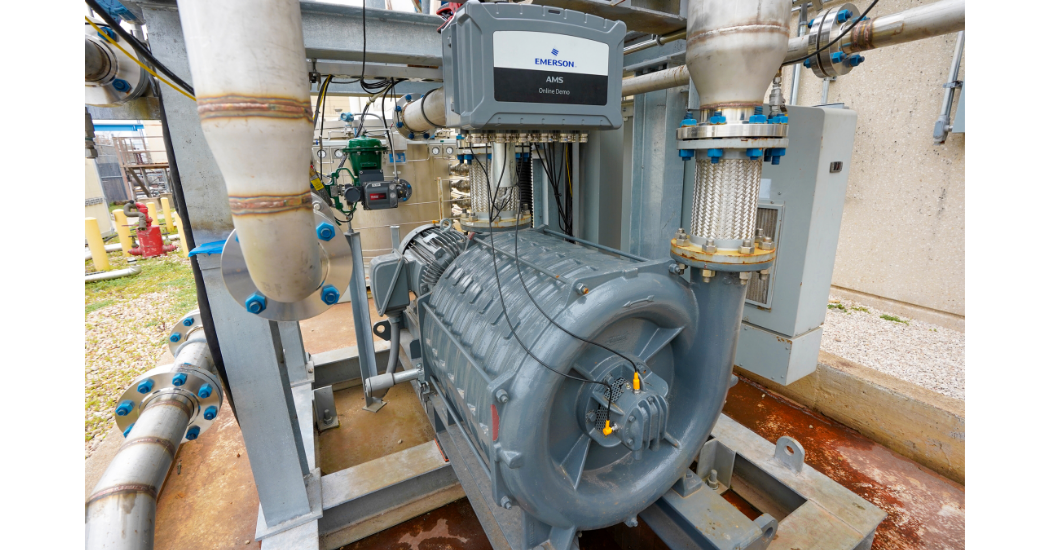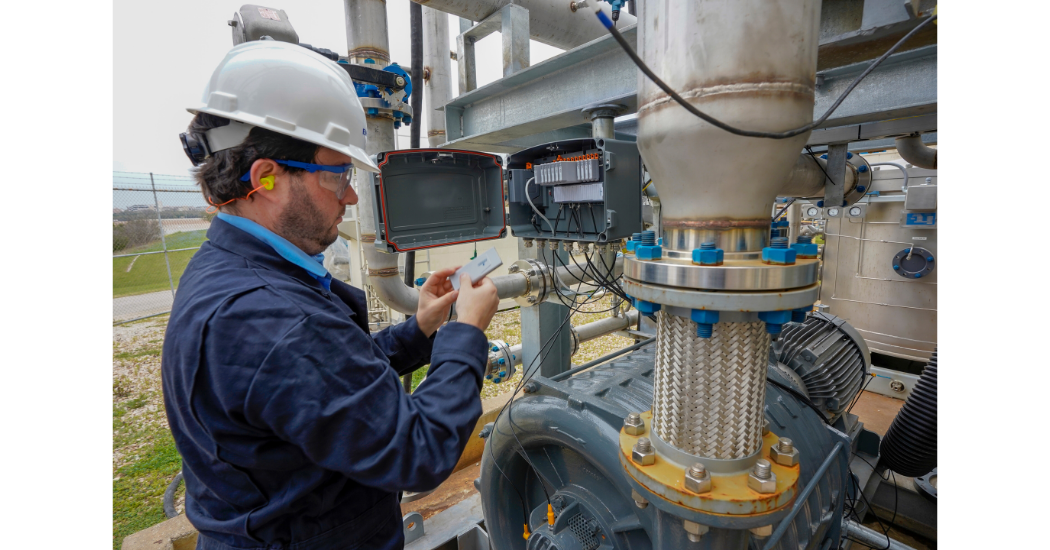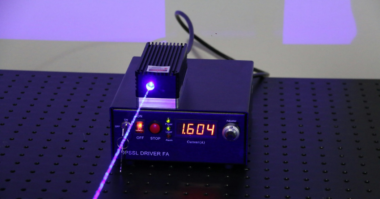When a remote monitoring device flashes a red light indicating that something is wrong with a critical piece of equipment, it can send a variety of plant operators into chaotic motion. Analysts spring into action to diagnose the problem. Engineers are deployed to the equipment to check it out. Mechanics and maintenance professionals grab their tool belts and rush to investigate.
Sometimes that flashing light can trigger the shutdown of the entire operation of an industrial plant until the problem can be identified and a solution implemented. Shutdowns like these can cost facilities hundreds of thousands of dollars per hour and often requires an entire team of workers to address and fix the problem.
Now, thanks to the ingenuity of Emerson’s AMS Asset Monitor and AMS Machine Works, that familiar red light delivers not only a diagnosis of the specific issue, but also tells plant personnel how to fix it. No expensive data scientists are required. There is no need for costly infrastructure to support the information transferring all the way up to the cloud and back. The innovative and sophisticated technology is designed to be simple to install, inexpensive, and easy to operate.
Emerson’s Drew Mackley puts the value of this sophistication into perspective.
“Think about a car’s check engine light,” he explains. “It lets you know there is a problem, but it doesn’t tell you what the problem is and requires additional clarifying diagnostics. A lot of monitoring systems will give you a red light, but then what do you do? This system provides more than just the red light. It tells you, ‘Hey, you have an imbalanced rotor, or under-lubricated bearing, or a cracked gear.’”
 Thanks to the instant, specific information provided by constant data coming into the on-line system, there is no longer a need for an expert to diagnose and explain the problem or provide a solution. Instead, the problem and solution flash onto the screen in plain text.
Thanks to the instant, specific information provided by constant data coming into the on-line system, there is no longer a need for an expert to diagnose and explain the problem or provide a solution. Instead, the problem and solution flash onto the screen in plain text.
“This solution really is designed for the masses,” Mackley says. “Now, I don’t have to be in the reliability department. I could be an operator, or an engineer, or an accountant and understand what is wrong and what needs to be done. You don’t have to be a data scientist and you don’t have to hire a data scientist.”
Because of traditionally high installation costs and complexity of the installation of most critical equipment monitoring systems, continuous online monitoring was previously reserved for only a plant’s most critical assets. Understanding vibration data and other intricacies required specific expertise. Collecting and analyzing process data was reserved for the control room.
The AMS Asset Monitor is an edge analytics device utilizing CHARMs-based technology to collect both vibration and process data from balance of plant (BOP) and essential assets. It applies embedded analytics to alert personnel to the common faults associated with a wide range of assets. Operations, process, and reliability staff can now all assist in monitoring plant equipment. “Going back to the car analogy, think about how you need a tire gage if the low-tire-pressure light comes on,” Mackley explains.
 “You have to manually check every tire. This device is the equivalent of the car telling you, ‘Your front left tire is low.’ It’s that specific. And you didn’t have to send the data to the cloud to know that.
“You have to manually check every tire. This device is the equivalent of the car telling you, ‘Your front left tire is low.’ It’s that specific. And you didn’t have to send the data to the cloud to know that.
It’s instant and locally analyzed. When the red light goes on you know the problem and the solution.”
Simply put, this type of advanced monitoring helps you “find the problems before you own the problems,” explains Emerson’s Brian Overton.
The AMS Asset Monitor can be used to monitor and diagnose all kinds of critical plant assets, including pumps, motors, compressors, fans, and even heat exchangers. And there are very few limits to the industries and environments that can utilize the edge-analytics technology.
“This is opening the door for companies to monitor equipment that they may not have been able to in the past because it was too costly,” Overton explains. “Now, they can get visibility into the operation and health of other machines. Also, it really reduces labor costs because the information about the solution is coming back rather than just a lot of data.”
The system provides recommendations based on the potential defect that has been detected by the system. For example, if it thinks the machine’s drive train is misaligned, causing excessive force on bearings and couplings, it will make a recommendation that a proper alignment is needed.
“We can give you tons of data, but what are you going to do with it?” asks Overton. “Are you just filling up a hard drive with a lot of data that is not going to get used? Or will that data be utilized with sophisticated artificial intelligence and critical machine-learning capabilities?”
 Depending on the size of the system, it’s possible to monitor all the assets in a plant, or just one. And thanks to the affordable cost of the device, the installation, and the operation, small-to-medium sized facilities can benefit from the technology as well as gigantic plants. “In many cases, years ago we would start with vibration and then apply it to whatever was out there,” Overton says. “These days, the premise is to start with the most critical machines.
Depending on the size of the system, it’s possible to monitor all the assets in a plant, or just one. And thanks to the affordable cost of the device, the installation, and the operation, small-to-medium sized facilities can benefit from the technology as well as gigantic plants. “In many cases, years ago we would start with vibration and then apply it to whatever was out there,” Overton says. “These days, the premise is to start with the most critical machines.
We first assess the criticality of the assets. If you have a critical asset break it could completely shut down your entire operation. Or perhaps you would focus on assets that could produce a safety hazard. We start with identifying the equipment to monitor that will provide the customer with the most bang for their buck. Then, we can build out the system to determine what other machines they want to monitor.”
First released in 2020, the AMS Asset Monitor got attention quickly. It was named a finalist for Product of the Year by Oil & Gas Engineering, one of Processing’s Break Through Products of 2020 and Plant Engineer’s Silver Award for 2020 Product of the Year. However, it’s the difference it makes for their customers that gets Emerson’s attention.
For example, an auto manufacturing facility was using an AMS Asset Monitor for a cooling tower application. Active monitoring with the Asset Monitor detected an issue with a gear box, which serviced the plant’s main facility compressor. Detection of this issue saved the plant $200,000 per hour of downtime. They were able to detect the issue before it became a catastrophic failure, which would have caused an even longer shutdown.
Another customer operating in the northern United States during the harsh cold month of February was feeding data through the OPC-UA communication protocol into their PLC system. There were operators watching the historian when they noticed vibration levels rising, but they didn’t know why.
The vibration was coming from a supply fan on the roof of a building. The intake to the fan had become frozen, blocking it completely. The process was beginning to interrupt and would have eventually caused a problem with the asset. Thanks to the AMS Asset Monitor, they knew instantly what to do and were able to dispatch someone to investigate. Without the continuous monitoring that showed the changes, they may not have noticed the problem until it was too late.
“This system provides information that you didn’t even ask for,” Overton explains.
Emerson’s edge-analytic technology is combined with the fast frequency of data collection from the online system—retrieving critical data every second. It is field deployable, which minimizes the engineering and configuration requirements.
“It’s very easy to put into operation,” Mackley adds. “It can be installed before lunch.”
As the system collects the data, there is built-in diagnostics that runs right in the unit. The data collection and analysis happen simultaneously. Onsite labor is not required to collect the data, key personnel can stay in safe areas, and there are no 30-day blind spots—the data is constantly collected. At all times, operators have knowledge of the health of the monitored assets. In addition, an on-staff, skilled vibration analyst is no longer needed to interpret the data. It doesn’t need to be connected to a server-based software system and the added expenses of the licensing of the software or
the IT footprint support that goes along with it are all eliminated.
“Anyone with a browser-enabled device (phone, tablet, or PC) can access the health of the asset at anytime from anywhere,” Mackley says.
There are no other systems on the market that can provide this level of detailed information without the need for a designated analyst to diagnose the information, Overton adds. “The analysis is provided in plain text.”
In addition to vibration monitoring, Emerson’s AMS Asset Monitor has the ability to incorporate process CHARMs (or inputs) that can measure a variety of variables, including temperature, pressure, and flow. There are outputs that could be used to flip a relay or cause a shutdown or protection action. Because of its versatility, process data combines with machinery health information to indicate more than just vibration analysis.
And because it’s an online system, “you can monitor assets while you are on vacation or while opening Christmas presents or while you are sleeping,” Mackley explains. “We will know at all times any changes that are taking place with the health of the assets or even process-related anomalies or disruptions.”
CHARMs are Emerson products that originated in its DeltaV control system. The acronym stands for Characterization Module. There are 12 CHARM slots in the unit for 12 sensors, or 12 channels of measurement. The CHARMs can be mixed and matched to make any flavor or measurement that you want in that device—making it completely customizable to what the end-user wants to know.
While the technology is designed to focus on a plant’s “work-horse” assets—like pumps, motors, compressors, and fans—it can be connected to any piece of equipment.

“We really like to think about this as pump monitoring for the masses,” Mackley says…Nothing else gives you continuous monitoring with multiple process input data combined with the analytics that doesn’t require a software system. It’s just so simple. It’s the easiest online system a plant will ever deploy.”
“We have streamlined the whole process to make getting the data easy but also making it easy to install,” he adds. “A lot of companies today are trying to do more with less human resources. You don’t need many resources to get this system up and going.”
This evolution of pump monitoring is changing the game for the industry, according to Mackley.
“This is a much more modern approach to pump monitoring,” he explains. “It’s available for customers who want to more easily monitor their assets with less labor, providing more visibility to the assets on a real-time basis, augmenting resource drains with imbedded intelligence and cutting-edge analytics. In doing so, it opens the monitoring of pumps to a wider range of customers. It’s not just for large refineries or large chemical plants who can afford to monitor critical pumps. It’s also a great solution for smaller facilities, wastewater treatment plants, food and beverage, or pharmaceutical facilities, that perhaps don’t otherwise have the resources or personnel to devote to sophisticated monitoring. Smaller sites may have pumps they would really like to monitor, but the lack of resources and capital has made it prohibitive for them in the past.”
For more information, follow this link.
This article was first published in our April Digital Magazine.
 About the Author:
About the Author:
Michelle Segrest is president of Navigate Content, Inc., a full-service content creation and publishing company. Check out her podcast, Factory of the Future, on YouTube and wherever you listen to podcasts. She can be reached at michelle@navigatecontent.com





Thank you for providing such an informative and well-structured blog post. The content was easy to follow, and I appreciated the additional resources you shared. To explore further, click here.